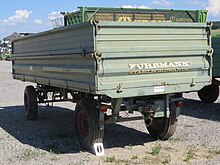Wheel chock
Wheel chocks (also wheel chocks ) are stable wedges made of metal, plastic or other suitable materials that are intended to prevent parked vehicles including trailers from rolling away by blocking at least one wheel. Regulations for the execution of wheel chocks are u. a. in DIN standards 76051-1 "wheel chocks for motor vehicles and trailers" and 76051-2 "wheel chocks for agricultural vehicles; functional dimensions".
Reinforced wedges, which are made of steel and have a toothing, are used, for example, in vehicles that have a built-in cable winch , since they not only have to prevent the vehicle from rolling away, but also from pulling away.
Road traffic regulations
Germany

The Road Traffic Licensing Regulations (StVZO) stipulate in Section 41, Paragraph 14, (status: October 19, 2012) that the following vehicles and trailers must be equipped with at least one wheel chock:
- Motor vehicles - except caterpillar vehicles - with a permissible total weight of more than 4 t,
- two-axle trailers (except semi- trailer, rigid drawbar and central -axle trailers ) with a permissible total weight of more than 750 kg,
The following must be equipped with at least two wheel chocks according to the same regulations:
- three- and multi-axle vehicles,
- Semitrailers,
- Rigid drawbar and central axle trailers with a permissible total weight of more than 750 kg.
When not in use, the wheel chocks belonging to the motor vehicle or trailer must be easily accessible in or on the vehicle with brackets so that they cannot be lost or rattle. Therefore, hooks or chains must not be used to hold wheel chocks.
Vehicle drivers are acc. StVZO, § 31b, obliged to provide competent persons such as B. to show items to be carried to the police and to hand them over to check that they are in compliance with regulations. This also includes wheel chocks.
The intentional or negligent commissioning of a motor vehicle (possibly with a trailer) in violation of the above-mentioned regulations on equipping with wheel chocks, their nature and attachment constitutes a traffic offense according to StVZO, § 69a, Paragraph 3, No. 13 .
Austria
In Austria, according to the Motor Vehicle Act 1967, §102 / 10:
"In the case of vehicles with a maximum gross vehicle weight of more than 3500 kg, with the exception of vehicles of class M 1 and in the case of trailers other than light, the driver must carry at least one wheel chock per vehicle."
The wheel chock must be sufficiently stable and adapted to the wheel size of the vehicle. Wheel chocks for tractors are therefore quite large and can be folded up for storage.
Wheel chocks are therefore one of the items of equipment to be carried with the vehicles mentioned .
While the German DIN standard also applies to motor vehicles in general, the wedges are described in ÖNORM L 5232 for agricultural and self-propelled machines.
Use with other types of vehicles
Wheel chocks on the railroad are called wheel chocks .
Airplanes are also secured by wedges when stationary on the runway.
Individual evidence
- ↑ Austrian Standards , accessed on August 1, 2018.
- ↑ Wheel chocks for agricultural towing vehicles and self-propelled machines in the construction database accessed on August 1, 2018

